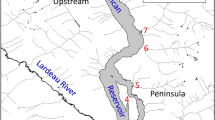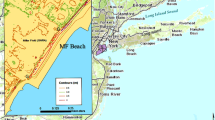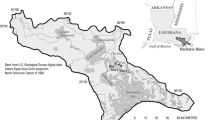Abstract
Wetland area, function and wildlife habitat value are extensively altered by the construction of freshwater reservoirs. We studied the effects of a temporary drawdown on shoreline vegetation communities of Felsenthal Navigation Pool (“the pool”), an impoundment at Felsenthal National Wildlife Refuge in southern Arkansas that is managed as a greentree reservoir. The pool was permanently flooded from 1985 until the summer of 1995 when the water level was dropped 0.3 m for about 16 weeks, exposing about 1,591 ha of soil. To document plant succession on the sediments exposed, we recorded plant species composition and cover at 14 transects along the pool margin prior to the drawdown, during the drawdown, and in the following summer. A soil disturbance treatment was applied near five transects following the drawdown, and soil was collected at each transect for seed bank and soil analyses. Plants colonized the drawdown zone quickly and high vegetation cover was present at some transects 4 weeks after the drawdown was initiated. Plants included species that are high quality food sources for waterfowl, including Cyperus erythrorhizos and Leptochloa fascicularis var. fascicularis. Vegetation response, measured by species richness, total cover, and cover of Cyperus species, was often greater at low compared to high elevations in the drawdown zone; this effect was probably intensified by low summer rainfall. Response on the disturbed transects was lower than that on the undisturbed transects. This effect was attributed to two factors: (1) removal of the existing seed bank by the disturbance applied and (2) reduced incorporation of seeds recruited during the drawdown because of unusually low rainfall. Seed bank studies demonstrated that several species persisted despite 10 years of continual flooding, and that seed bank species richness increased during the drawdown. Although conclusions are limited by the 1-year time frame of the study, it is unlikely that permanent change to plant community structure in the drawdown zone resulted from the lowered water level.






Similar content being viewed by others
References
Baskin CC, Baskin JM (1998) Seeds—ecology, biogeography and evolution of dormancy and germination. Academic Press, San Diego
Baskin CC, Baskin JM, Chester EW (1993) Seed germination ecophysiology of four summer annual mudflat species of Cyperaceae. Aquat Bot 45:41–52. doi:10.1016/0304-3770(93)90051-W
Bonham CD (1989) Measurements for terrestrial vegetation. John Wiley and Sons, New York
Bossuyt B, van Wichelen J, Hoffman M (2007) Predicting future community composition from random soil seed bank sampling—evidence from a drained lake bottom. J Veg Sci 18:443–450. doi:10.1658/1100-9233(2007)18[443:PFCCFR]2.0.CO;2
Broadfoot WM (1958) Reaction of hardwood timber to shallow-water impoundments. Mississippi State University Agricultural Experiment Station Information Sheet 595, Mississippi State University, Stoneville
Broadfoot WM (1967) Shallow-water impoundment increases soil moisture and growth of hardwoods. Soil Sci Soc Am Proc 31:562–564
Brock SC, Arner DH, Steffen DE (1994) Seed yields of four moist-soil plants on Noxubee National Wildife Refuge. Proc Ann Conf Southeast Assoc Fish Wild Agencies 48:38–47
Casanova MT, Brock MA (2000) How do depth, duration and frequency of flooding influence the establishment of wetland plant communities? Plant Ecol 147:237–250. doi:10.1023/A:1009875226637
DeBerry DA, Perry JE (2005) A drawdown flora in Virginia. Castanea 70:276–286. doi:10.2179/0008-7475(2005)070[0276:ADFIV]2.0.CO;2
Ervin GN, Majure LC, Bried JT (2006) Influence of long-term greentree reservoir impoundment on stand structure, species composition, and hydrophytic indicators. J Torrey Bot Soc 133:468–481. doi:10.3159/1095-5674(2006)133[468:IOLGRI]2.0.CO;2
Fenner M, Thompson K (2005) The ecology of seeds. Cambridge University Press, Cambridge
Fredrickson LH (1991) Waterfowl management handbook. Fish and Wildlife Leaflet 13.4.6—Strategies for water level manipulations in moist-soil systems. US Fish and Wildlife Service, Washington, DC
Fredrickson LH (2005) Greentree reservoir management—implications of historic practices and contemporary considerations to maintain habitat values. In: Fredrickson LH, King SL, Kaminski RM (eds) Ecology and management of bottomland hardwood systems—the state of our understanding. Gaylord Memorial Laboratory special publication no. 10. University of Missouri, Columbia, pp 479–486
Fredrickson LH, Batema DL (1992) Greentree reservoir management handbook. Wetland management series no. 1. Gaylord Memorial Laboratory. University of Missouri, Columbia
Fredrickson LH, Reid FA (1988) Waterfowl management handbook. Fish and Wildlife Leaflet 13.4.9—Preliminary considerations for manipulating vegetation. US Fish and Wildlife Service, Washington, DC
Fredrickson LH, Taylor TS (1982) Management of seasonally flooded impoundments for wildlife. US Fish and Wildlife Service Resource Publication 148, Washington, DC
Gray MJ, Kaminski RM (2005) Effect of continuous flooding versus periodic winter flooding on survival of oak seedlings in Mississippi greentree reservoirs. In: Fredrickson LH, King SL, Kaminski RM (eds) Ecology and management of bottomland hardwood systems—the state of our understanding. Gaylord Memorial Laboratory special publication no. 10. University of Missouri, Columbia, pp 487–493
Gray MJ, Kaminski RM, Weerakkody G, Leopold BD, Jensen KC (1999) Aquatic invertebrate and plant responses following mechanical manipulations of moist-soil habitat. Wildl Soc Bull 27:770–779
Keddy PA, Reznicek AA (1982) The role of seed banks in the persistence of Ontario’s coastal plain flora. Am J Bot 69:13–22. doi:10.2307/2442827
Keeland BD, Conner WH (1999) Natural regeneration and growth of Taxodium distichum (L.). Rich in lake Chicot, Louisiana, after 44 years of flooding. Wetlands 19:149–155
King SL, Allen JA (1996) Plant succession and greentree reservoir management—implications for management and restoration of bottomland hardwood wetlands. Wetlands 16:503–511
King SL, Allen JA, McCoy JW (1998) Long-term effects of a lock and dam and greentree reservoir management on a bottomland hardwood forest. For Ecol Manage 112:213–226
Leck MA (1989) Wetland seed banks. In: Leck MA, Parker VT, Simpson RL (eds) Ecology of soil seed banks. Academic Press, San Diego, pp 283–304
Leck MA, Simpson RL (1995) Ten-year seed bank and vegetation dynamics of a tidal freshwater marsh. Am J Bot 82:1547–1557. doi:10.2307/2446183
Leeds JA, Smith SM, Garrett PB (2002) Seedbanks and their potential role in the vegetation dynamics of a northern Everglades marsh. Fla Sci 65:16–34
Lockaby BG, Wheat RS, Clawson RG (1996) Influence of hydroperiod on litter conversion to soil organic matter in a floodplain forest. Soil Sci Soc Am J 60:1989–1993
Malecki RA, Lassoie JR, Rieger E, Seamans T (1983) Effects of long-term artificial flooding on a northern bottomland hardwood community. For Sci 29:535–544
Meeks RL (1969) The effect of drawdown date on wetland plant succession. J Wildl Manage 33:817–821. doi:10.2307/3799312
Merz RW, Brakhage GK (1964) The management of pin oak in a duck shooting area. J Wildl Manage 28:233–239. doi:10.2307/3798082
Middleton B (2000) Hydrochory, seed banks, and regeneration dynamics along the landscape boundaries of a forested wetland. Plant Ecol 146:169–184. doi:10.1023/A:1009871404477
Middleton B (2003) Soil seed banks and the potential restoration of forested wetlands after farming. J Appl Ecol 40:1025–1034. doi:10.1111/j.1365-2664.2003.00866.x
Moore DRJ, Keddy PA (1988) Effects of a water-depth gradient on the germination of lakeshore plants. Can J Bot 66:548–552
Petersen JE, Baldwin AH (2004) Seedling emergence from seed banks of tidal freshwater wetlands: response to inundation and sedimentation. Aquat Bot 78:243–254. doi:10.1016/j.aquabot.2003.10.005
Poiani KA, Johnson WC (1988) Evaluation of the emergence method in estimating seed bank composition of prairie wetlands. Aquat Bot 32:91–97. doi:10.1016/0304-3770(88)90090-3
Poiani KA, Johnson WC (1989) Effect of hydroperiod on seed-bank composition in semipermanent prairie wetlands. Can J Bot 67:856–864. doi:10.1139/b89-115
Reineke KJ, Kaminski RM, Moorehead DJ, Hodges JD, Nasser JR (1989) Mississippi alluvial valley. In: Smith LM, Pederson RL, Kaminski RM (eds) Habitat management for migrating and wintering waterfowl in North America. Texas Tech University Press, Lubbock, pp 203–247
Rossell IM, Wells CL (1999) The seed banks of a southern Appalachian fen and an adjacent degraded wetland. Wetlands 19:365–371
Schneider RL, Sharitz RR (1986) Seed bank dynamics in a southeastern riverine swamp. Am J Bot 73:1022–1030. doi:10.2307/2444121
Schumacher BA, Neary AJ, Palmer CJ, Maynard DG, Pastorek L, Morrison IK, Marsh M (1995) Laboratory methods for soil and foliar analysis in long-term environmental monitoring programs. US Environmental Protection Agency Report EPA/600/R-95/077. US Environmental Protection Agency, Las Vegas
Smith LM, Kadlec JA (1983) Seed banks and their role during drawdown of a North American marsh. J Appl Ecol 20:673–684. doi:10.2307/2403534
Soil and Plant Analysis Council (1992) Determination of organic matter by loss-on-ignition. In Handbook on reference methods for soil analysis. Council on Soil Testing and Plant Analysis, Georgia University Station, Athens, Georgia, pp 172-174
Souther RF, Shaffer GP (2000) The effects of submergence and light on two age classes of baldcypress (Taxodium distichum (L.) Richard) seedlings. Wetlands 20:697–706. doi:10.1672/0277-5212(2000)020[0697:TEOSAL]2.0.CO;2
Integrated Taxonomic Information System (2007) Integrated Taxonomic Information System. http://www.itis.gov. Cited 7 Nov 2007
ter Heerdt GNJ, Drost HJ (1994) Potential for the development of marsh vegetation from the seed bank after a drawdown. Biol Conserv 67:1–11. doi:10.1016/0006-3207(94)90002-7
Thompson K, Bakker JP, Bekker RM, Hodgson JG (1998) Ecological correlates of seed persistence in soils in the north-west European flora. J Ecol 86:163–169. doi:10.1046/j.1365-2745.1998.00240.x
Twedt DJ, Nelms CO, Rettig VE, Aycock SR (1998) Shorebird use of managed wetlands in the Mississippi alluvial valley. Am Midl Nat 140:140–152. doi:10.1674/0003-0031(1998)140[0140:SUOMWI]2.0.CO;2
van der Valk AG, Pederson RL (1989) Seed banks and the management and restoration of natural vegetation. In: Leck MA, Parker VT, Simpson RL (eds) Ecology of soil seed banks. Academic Press, San Diego, pp 329–346
Welling CH, Pederson RL, van der Valk AG (1988) Temporal patterns in recruitment from the seed bank during drawdowns in a prairie wetland. J Appl Ecol 25:999–1007
Wilson CH, Moore DRJ, Keddy PA (1993) Relationships of marsh seed banks to vegetation patterns along environmental gradients. Freshw Biol 29:361–370. doi:10.1111/j.1365-2427.1993.tb00770.x
Young GL, Karr BL, Leopold BD, Hodges JD (1995) Effect of greentree reservoir management on Mississippi bottomland hardwoods. Wildl Soc Bull 23:525–531
Acknowledgments
We appreciate the assistance provided by the staff at Felsenthal NWR throughout the study. Most notably, the logistical support and help provided by R. Ellis in locating sampling sites, collecting data, and identifying plant species were essential. We thank D. Johnson for completing statistical analyses, J. Biagas for help with field data collection and graphics preparation, and C. Boudreaux for graphics assistance. Historical data on water levels at Felsenthal lock and dam were provided by B. Keeland. Comments on the manuscript from S. Faulkner, T. Michot, R. Dale, B. Middleton, J. Waide, and two anonymous reviewers are greatly appreciated. The use of trade, product or firm names does not constitute endorsement or recommendation for use by the US Government.
Author information
Authors and Affiliations
Corresponding author
Rights and permissions
About this article
Cite this article
Howard, R.J., Wells, C.J. Plant community establishment following drawdown of a reservoir in southern Arkansas, USA. Wetlands Ecol Manage 17, 565–583 (2009). https://doi.org/10.1007/s11273-009-9134-x
Received:
Accepted:
Published:
Issue Date:
DOI: https://doi.org/10.1007/s11273-009-9134-x




